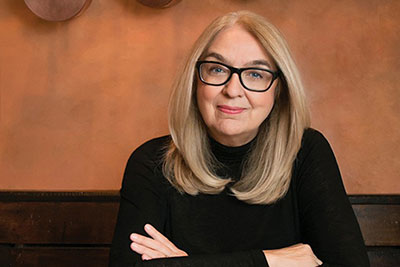Winterguide 2019 | view this story as a .pdf
Ann Hood guides us through “life, love, and food” in her new collection of essays, Kitchen Yarns.
By Olivia Gunn Kotsishevskaya
 “I’ve been happily reading the newspaper,” Ann Hood says during my phone call that’s interrupted her morning routine. “Well.” She stops. “Not happily, because the news is never good.” She’s got a voice like Bacall (but natural, not honed) and a sweet, warming humor. Full disclosure: As a home kitchen dweller and reader, I’m smitten.
“I’ve been happily reading the newspaper,” Ann Hood says during my phone call that’s interrupted her morning routine. “Well.” She stops. “Not happily, because the news is never good.” She’s got a voice like Bacall (but natural, not honed) and a sweet, warming humor. Full disclosure: As a home kitchen dweller and reader, I’m smitten.
“I’d almost call it an accidental book,” Hood says of her newest, Kitchen Yarns. She’s written numerous books and essays throughout her career, which kicked off with her first novel, Somewhere Off the Coast of Maine, published in 1987 when she was still working as a flight attendant for TWA.
“It wasn’t until someone pointed out to me, ‘Do you know you use food a lot in many of your essays?’” that her new project sparked. “It wasn’t really intentional. I just believe food is such a portal into bigger emotions, that when you’re trying to write about grief, or disappointment, or even something joyful, it’s easy to land on a happy food or a sad food memory as a way to explore a larger theme.”
And the memories overflow in Kitchen Yarns. Hood guides us from her childhood home’s tiny kitchen filled with the aromas of red sauces, fresh vegetables, and herbs to the streets of Rome, where she fell madly in love—with spaghetti carbonara.
“I’m from an Italian-American family. We moved into the house where my family lived [since] 1887. When I was a kid, we used to have a building we called ‘the shack.’ It was just one big room: screened windows, a big six-burner stove, a double sink, and a table. It was in West Warwick, [Rhode Island], a small mill town, all immigrant families. There was a big community garden everyone in the neighborhood shared. It was very common for me when I was young to see women coming from that garden with baskets they’d made themselves overflowing with eggplants, tomatoes, fruits. So we had this building called the shack, and I just have so many memories. There was a big kitchen table—I actually have that table now—chairs, and a couch. And I used to lie on that couch on a hot summer day and just watch my grandmother and great-grandmother roll out pasta, cut watermelon, cook corn, make sauces. We’d all eat in there because it was cooler than the house.
“Then, you know, progress happened. My great-grandmother died, we rearranged the yard, and the shack was knocked down. From then on, all our family meals were cooked in a tiny kitchen—no counter. Somehow, as many as forty people would be fed inside that kitchen on Sundays and on holidays. My grandmother was the matriarch of the family after my great-grandmother died. She was around four foot eleven. Bright red hair—not dyed. It just never turned gray. Curly hair. She’d stand in there, and out of that kitchen would come our lasagnas at Christmas, the seven fishes for Christmas Eve. After she died, it was my mom in there. My mom passed away in February, and I’m getting ready to sell the house. It’s a very emotional time for this book to come out. We’ve had it since 1887. How many years is that?”
The essays included in the collection were written over the last 10 years, a decade that’s presented Hood with plenty of material on top of an already colorful life. After winning the Best American Food Writing Award for her essay “Tomato Pie,” the last essay in Kitchen Yarns, Hood’s editor told her to look through more of her work. “I did that and realized that, yes, I did have a lot but not very many that were representing my present life—I’d gone through some big life changes. So from that luncheon to last year, about two more years, I wrote around three or four new essays that dealt with life changes like my son going off to college, getting a divorce, moving out of my home I’d been in for 25 years, and then a happy ending—getting remarried.”
Hood doesn’t sensationalize the moments you might expect her to. She maintains a stunning candor in her writing. In “My Father’s Pantry,” she tells of her father’s battle with lung cancer and how a simple box of Shake ’n Bake still offers a dose of reassurance. In “Allure,” she writes of a time in her life when she was “living the exact life I should be living,” without keeping from us the monumental losses she’s suffered: her brother’s sudden death at 30 in a home accident, the death of her five-year-old daughter, Grace—she couldn’t write for two years after Grace’s death. Hood never shies away from the good, the bad, or the ugly matters of life. Not to mention the recipes.
“But there was a brief time when I felt solid, rooted, happy, right…
My friends lived in my neighborhood, in historic houses like mine. There were filmmakers and artists and dancers and writers, and on weekend nights we drank wine and ate expensive cheese, fed our kids quesadillas and put on a video for them to watch while we ate coq au vin or mustard chicken. On one of these nights someone proposed a progressive dinner: appetizers at one house, main course at another, dessert at a third…
Again, I can’t remember what we ate, just the memory of one woman taking all the kids to her house across the street to watch a video and the stars hanging heavy over us that summer night… So Mary—she was in charge of dessert—went home and came back with two beautiful peach pies. These were not typical peach pies. They had a shortbread crust and a moist filling and the peaches were ripe and perfect, as only peaches can be at a certain time in summer. In his poem “From Blossoms,” Li-Young Lee writes about the pleasure of eating “not only the sugar, but the days.” —From Kitchen Yarns
“Food ultimately brings comfort—whereas some songs that come on, you burst into tears, or if you see a picture or catch a certain scent. I lost my daughter Grace when she was five in 2002. She died in April. Her sixth birthday would’ve been in September. She was only five, so she didn’t have a very sophisticated palate. But her favorite meal was just pasta, butter, and Parmesan cheese. And she loved cucumbers. So a dream dinner was that and sliced cucumbers. I’ve eaten that on her birthday every day since 2002 when she died. It just still connects me to her. There are some things I still haven’t been able to do even though it’s been 16 years. But eating her favorite meal and remembering cooking it for her, sitting next to her while she ate it, the funny way she said ‘noodles.’ That dinner, simple as it is, still brings me comfort.”
And that bite that whisks her to treasured days like Proust’s madeleines in Remembrance of Things Past? “Scallion pancakes and fried dumplings at Hua Yuan, my favorite Chinese restaurant on 42 East Broadway in Manhattan, always bring me back to China, where streets are lined with woks filled with bubbling oil to fry these up. That was 2005, when we went to adopt my daughter, Annabelle.”





0 Comments